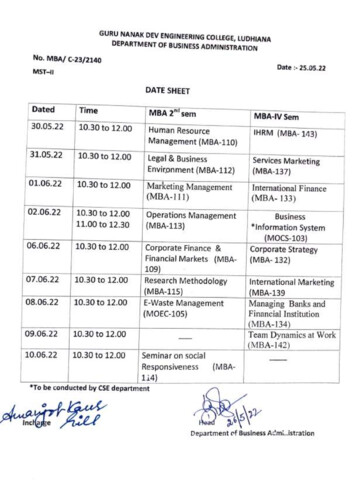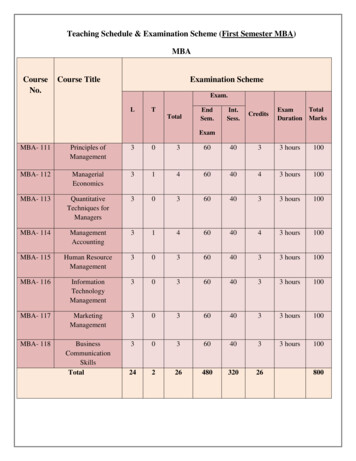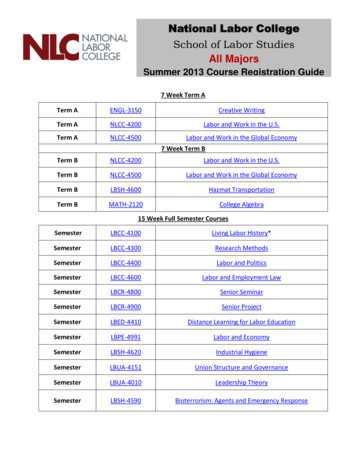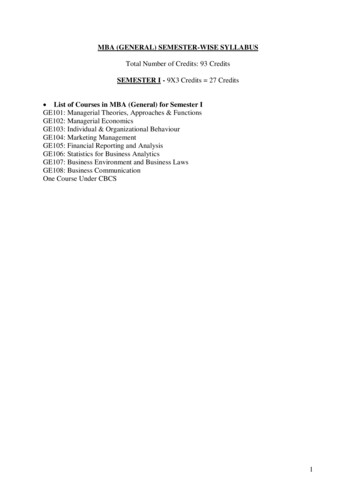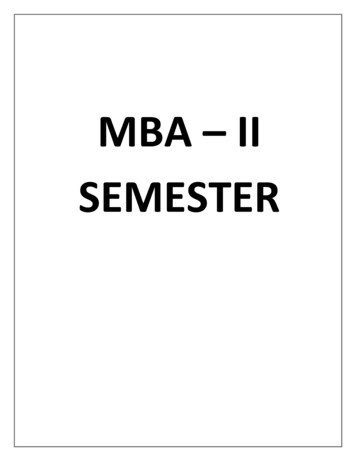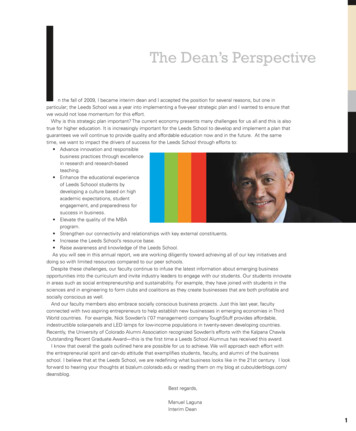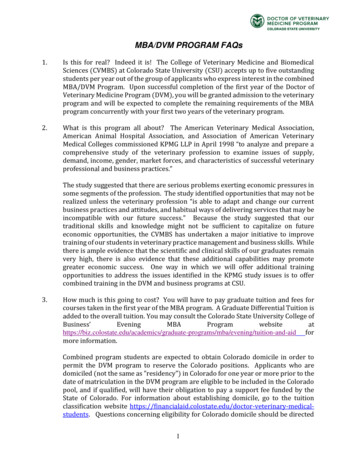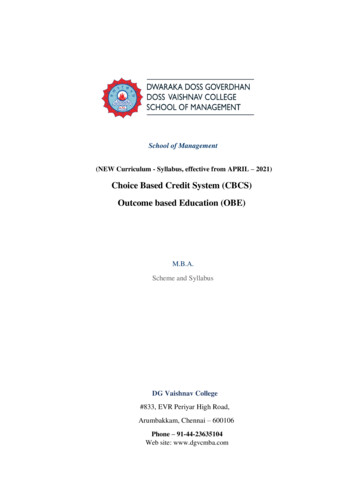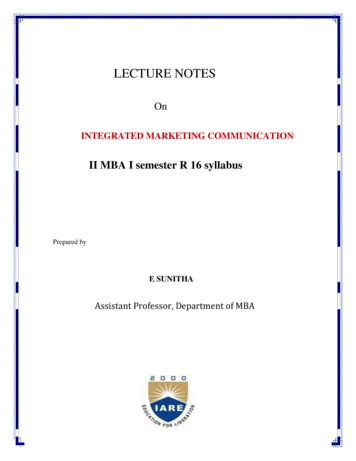
Transcription
LECTURE NOTESOnINTEGRATED MARKETING COMMUNICATIONII MBA I semester R 16 syllabusPrepared byE SUNITHAAssistant Professor, Department of MBA
MASTER OF BUSINESS ADMINISTRATIONINSTITUTE OF AERONAUTICAL ENGINEERING(Autonomous)DUNDIGAL- 500 043, HYDERABAD
gratedmarketingcommunication, integrated marketing communication as an integral part ndingthecommunication process, communication RATED MARKETING COMMUNICATIONSSetting communication objectives, Dagmar approach to setting objectives andmeasuring advertising effectiveness, allocating the marketing communicationbudget, conducting research to measure communication effectiveness, posttesting tools and techniques, evaluating other promotional tools.UNITIIIMARKETING COMMUNICATION MIX ICreative execution in advertising, decision in print, execution radio, executionon online and television, getting that ‘big idea’ of creativity.UNITIVMARKETING COMMUNICATION MIX IISales promotion, direct marketing, personal public relations, publicity edia:sponsorships,mobile advertising, word of mouth, village farmers, out of home media, worldwide web communications.UNIT-VREGULATION, SOCIAL AND ETHICAL ASPECTS OFADVERTISING AND PROMOTIONFederal regulation of advertising, regulations of advertising and promotion inIndia, regulation of other promotional areas, social and ethical criticisms ofadvertising, ethical aspects of advertising, truth in advertising, advertising tochildren, advertising controversial products, social aspects of advertising.
UNIT - IUNDERSTANDINGINTEGRATED MARKETING COMMUNICATION
What is marketing:Marketing is the study and management of exchange relations. Marketingis used to create, keep and satisfy the customer. With the customer as thefocus of its activities, it can be concluded that Marketing is one of thepremier components of business management the other being innovationDefinition:Marketing is defined by the American Marketing Association as"the activity, set of institutions, and processes for creating, communicating,delivering, and exchanging offerings that have value for customers, clients,partners, and society at large." The term developed from the originalmeaning which referred literally to going to market with goods for sale.From a sales process engineering perspective, marketing is"a set of processes that are interconnected and interdependent with otherfunctions" of a business aimed at achieving customer interest andsatisfaction.Philip Kotler defines marketing as“marketing is about Satisfying needs and wants through an exchangeprocess”Marketing CommunicationMarketing communications (MC, marcom(s), marcomm(s)) uses differentmarketing channels and tools in combination: Marketing communicationchannels focuses on any way a business communicates a message to itsdesired market, or the market in general. A marketing communication toolcan be anything from: advertising, personal selling, direct marketing,sponsorship, communication, promotion and public relations.[1]Marketing communications are made up of the marketing mix which ismade up of 4P's: Price, Promotion, Place and Product, for a business selling
goods, and made up of 7P's: Price, Promotion, Place, Product, People,Physical evidence and Process, for a service based sadvertising,promotions,sales,branding and online promotion.[3] The process allows the public businessesuse to know or understand a brand. Successful branding involves targetingaudiences who appreciate the organization's marketing program.Advertising is a small but important part of marketing communications;the marketing communications mix is a set of tools that can be used todeliver a clear and consistent message to target audiences. It is alsocommonly called the promotional mix. Crosier (1990) states that all termshave the same meaning in the context of the 4ps: Product, price, place andpromotion.[1] Price can send a message to the target audience. For example,comparing a 50 bag to a 10 bag, the former may be view as a luxury ormore durable item.The marketing plan identifies key opportunities and threats, set objectivesand develops an action plan to achieve marketing goals. Each section of the4P's sets its own object; for instance, the pricing objective might be toincrease sales in a certain geographical market by pricing their ownproduct or service lower than their competitors. This creates a significantchange in the market because more people of the target market would aimto do business with your organization than your competitors, becausepricing is one of the most significant aspects of marketing that can changethe whole market positively and or negatively.CommunicationCommunication is one important aspect of the marketing mix. Marketingcommunication is often the largest component of communication within acompany, which may be to present company values, objectives or specificproducts and services to investors, customers or the general public. In the21st century, communications objectives focus on more customized
messages, targeting customer groups or individuals to create highresponses and greater brand interaction.As business becomes increasingly global with greater access to Internet,mobile phones and social media, new challenges exist to inform people intargeted foreign markets. Shifts in the global economy and access to newmarkets lead also to greater demands for product shipping and associatedservices. To be effective, communication strategies must converge withmarketing objectives while also accounting for local languages, dialects andcultural norms.External communications might involve market research questionnaires,office website, guarantees, company annual report and presentations forinvestors. Internal communication can be the marketing materials, anagementcommunications. On the other hand, each market demands different typesof communications. For example, the industrial market demands a morepersonal communication but the consumer market demands non-personalcommunication.[5]There are also 4 different fundamental types of communication. One-to-many: this kind of communication is the most originalcommunication. It is "generated from a single broadcast point and thenavailable over airwaves or in mass print runs[5]". This type ofcommunication is usually adapted to news distribution that does notspecific not even interactive. Such as in an urgent notice play overairwave from broadcast in an industry, it is helpful for the generalannouncement. Many-to-one: many-to-one is usually connected to the one-to-manycommunication.[5] For example, a reply button in your email box, aprepaid number bought from Spark. All the communication techniquesproceeded to the public with bi-directional communication from masscommunications. One-to-one: this is the most intensive and interactive communicationat a one-to-one level.[5] There are so many examples like a salespresentation; a negotiation in the market or direct delivery is base on the
one-to-one communication. Most of this communication is face to face.But in the development of Internet, email and online shopping are takingplace the chance to face to face of people. Which is provided the chanceto sellers and buyers talk more directly. Another important is instantmessage 'chat' channel like Wechat and Facebook, which are becomingextremely popular in business.Many-to-many: on the background of highly developed Internet, the many-to-many communication has been growing up such as online chatrooms, 'blogging' websites.[5] The many-to-many communication standsfor the participants are able to exchange their ideas and experiences.One-to-one is more immediate, while the many-to-may channels tend to beless urgent but with greater longevity.Transactional Model of CommunicationCommunication can be defined as process of using, word, sound or visualcues to supply information to one or more people. A communicationprocess is defined as information that is shared with the intent that thereceiver understands the message that the business intended to send.[7]The communication process was once thought of as having the source ncommunication channel, which is then decoded by the recipient and thenreceived.[8] Throughout the middle of the channel there is the potential fornoise to distort the message being sent. Once the receiver has the messagethey then give feedback to the original source, where they then find outwhether the campaign has been successful or not.With the prevalent use of technology, customers are seeking outinformation about brands, products and businesses prior to purchase. Thismeans that there is a need for an additional channel within thecommunication process, so it is a more accurate representation of thecurrent business environment. Businesses are now having to take intoconsideration that both opinion leaders and opinion formers who have agreat influence over today's society and their perceptions. So they have tobe included into the communication process before the recipient of themessage receives it.
This model is more effective when there is common ground between thesenders and receivers so they can communicate effectively. Choosing theappropriate source helps develop the message and appeal to the targetedaudience. The source will be more effective if they are relatable to the targetaudience. This realm of understanding is represented by the overlappingcircles. The more knowledge the source has about who they are targeting,the better they can understand how the receiver may interpret or react tothe message.The components of the transactional model are: Source: The source is an individual or organization that hasinformation to share. The source (or sender) creates and sends theinformation to another person or group of people. The source maybe anindividual (e.g. a sales person or spokesperson) or a non-personalidentity (e.g. a corporation or organization). The communication processbegins with the source, marketers must carefully choose a source as itaffects how the message will be perceived by the target audience. Encoding: This is transposing the intended meaning of the messagewith words, symbols or pictures to show a message. Encoding is thedevelopment of the message that contains the information the sourcehopes to convey. It is putting together the thoughts, ideas andinformation into a symbolic form that can be transmitted and understoodby the receiver. Encoding the message is the second step in thecommunication process. The encoding process leads to development of amessage that contains the information or meaning the source hopes toconvey. Encoding is extremely important, it is a brain activity that takeseffect when the receiver makes sense of a brand message or idea used toconvey meaning: words, colour, pictures, signs, symbols or even music.The message may be verbal or nonverbal, oral or written, or symbolic (e.g.the sound of a brass band being redolent of simpler times or heritage). orit can often include 'cues' such as the Nike 'swoosh' which indicatessuccess. Often things can get in the way of the "correct" encoding and theinterpretation of the intended message (decoding). There are methods thesender can use to make sure the receiver interprets the message
correctly, these methods include; channels, consumer insights, havingsimilarities with the receiver and frame of reference (e.g. age, values,culture). Finally, it is extremely important for the sender to get to knowits receiver and this is accomplished through research for targetingstrategy. These concepts help craft the intended message in the minds ofthe consumer. Message: The message comes from the encoding process, it is thecontent, meaning or information the sources hopes to convey. Themessage can be in many forms such as verbal, non-verbal, oral, writtenor symbolic. Channel: The channel is the method by which the communicationtravels from the source or sender to the receiver.[8] There are two types sofcommunication are direct and target individual groups. Personalcommunication channels are connected with two or more persons whocommunicate directly with each other face-to-face, person-to-personthrough telephone, email or fax. Social channels also fall under thecategory of personal communications. Friends, neighbors, associates, coworkers, or family members are all means of social channels.[3] Carryinga message without interpersonal contact between sender and receiver isknown as non-personal channels of communication. Mass media or masscommunications are examples of non-personal channels, since themessage is sent to many individuals at one time. Non-personal channelsof communication are made up out of two main types, the first beingprint. Print media includes newspapers, magazines, direct mail, andbillboards. The second type is broadcast; broadcast media includes radioand television. Decoding: The receiver unravels the symbols to interpret what isbeing communicated. Transforming the sender's message back intothought. This is influenced greatly by the receiver's frame of reference (orrealm of understanding) which involves their values, attitudes and stateof mind when receiving the message. For the model to be effective thedecoding by the receiver would match the encoding by the source,
meaning they correctly understand the message that was sent.[11]Decoding is the process of interpreting messages and relies on correctencoding and the ability of the receiver to deconstruct transmittedmeaning. Decoding occurs when the message reaches one or more of thereceiver's senses. Consumers both hear and see television ads, othersconsumers handle (touch) and read (see) an advertising offer (e.g.coupon). According to Belch & Belch this process is deeply influenced bythe receiver's frame of reference or field of experience, which refers to theexperiences, perceptions, attitudes, and values he or she brings to thecommunication situation.[8] For effective communication to occur, themessage decoding process of the receiver must match the encoding of thesender. Over this entire means the receiver comprehends and ate.Effectivecommunication is more likely to emerge when there is some commonground between the two parties. The more familiarity the sender hasabout the receivers, the better the sender can understand their needs,commiserate with them, and over all communicate more effectively. Receiver: The individual (s) that the source shares thoughts orinformation with. The receiver hears, sees or reads the message anddecodes it. Noise: Noise is any external interference during this communicationprocess. Any external factors that creates unplanned distortion. Thisdistortion can make it difficult for the receiver to interpret or assignmeaning to a message as it was intended by the source. Examples ofnoise in the encoding of the message could be lack of radio or televisionsignal. Noise can also occur when the sender and receivers fields ofexperience do not overlap, if there is no common ground between them,which may result in a misunderstanding in the meaning of themessage.[11] Throughout the communication process, the message issubject to irrelevant factors that can distort or interfere with itsreception. Noise is the physical or Psychological fundamentals either frominside or outside of the process of communication. Noise acts as a barrieras it makes the message less accurate, less productive and unclear. Itmay even prevent the message from ever reaching the receiver. Physical
noise is often triggered by badly made images or messages (e.g. poor printquality) or elements of distraction (e.g. consumer scrolling through TVadvertisements). Psychological noise could be mixed meanings, poorcredibility of source or the insignificance of the message to the consumerrequirements. Not having a connection with the receiver and lacking incommon ground usually cause this. This may result in unsuitableencoding of the message such as; using a sign, symbol, or word that isunfamiliar or has different meaning to the receiver (e.g. sending amessage in foreign language that is not understood by the receiver). Themore common ground there is between the sender and the receiver, theless likely it is for noise and barriers to interrupt a message. Response/Feedback: The receiver's reaction to the message providesfeedback to the sender. This is the set of reactions after seeing, hearingor reading the message. The receiver's response is the feedback and letsthe sender know how the message was decoded and received. A form offeedback in an interpersonal selling situation could be questions,comments or any reactions (such as expressions) about the message. Inmass media an indication of how the marketing communications wereperceived is the amount of sales after the message has been sent. Thereare many different ways such as attitude change, store visits andinquires that provide feedback in mass media. Feedback can help uremessages.[11] The receiver's particular type of reactions after seeing,hearing, or reading a message is known as a response. Receivers'responses can range from either non noticeable actions or noticeableactions. Non noticeable responses can be storing their information inmemory and noticeable responses are immediate action such as dialingthe commercials number to order a product advertised on television. Oneof the main goals of communication is receiving appropriate receiverresponses, feedback closes the loop in the communications flow and letsthe sender monitor how the intended message is being decoded andreceived. To achieve this goal one can ask indirectly or directly for theresponse, or assist the receiver in giving the response.[3] Receiving feedback can be more difficult for parties that advertise through the channelsof mass media, because advertisers are not in direct contact with their
customers so other methods must be obtained to determine how theirmessages have been received. While the critical form of feedback happensthrough sales, it is often hard to show a direct relationship betweenadvertising and purchase behavior. So marketers; visit stores, checkcoupon redemption, use reply cards and listen to customer inquiries toachieve feedback. Once a significant amount of feedback/response studyhas been gathered advertisers would then have enough information todetermine reasons for success or failure in the communication processand from there they can make appropriate adjustments.Integrated marketing communicationsIntegrated marketing communications (IMC) is the use of marketingstrategies to optimise the communication of a consistent message of thecompany's brands to stakeholders.[52] Coupling methods together improvescommunication as it harnesses the benefits of each channel, which whencombined together builds a clearer and vaster impact than if usedindividually.[53] IMC requires marketers to identify the boundaries aroundthe promotional mix elements and to consider the effectiveness of thecampaign's message.[54]In the mid to late 1980s, the marketing environment was arketingfragmentation,globalisation of markets, the advent of new communications technologies,the widespread use of databases meant that the old methods, and practicesused in mass marketing were no longer relevant. In particular, the rise ofdigital and interactive media meant that marketers were relying less onadvertising as the dominant form of marketing communications. Amongstpractitioners and scholars, there was an increasing recognition that newapproaches to marketing communications were required. That newapproach would become known as integrated marketing communications. Anumber of empirical studies, carried out in the early 1990s, found that thenew IMC was far from a "short-lived managerial fad," but rather was a veryclear reaction by advertisers and marketers to the changing externalenvironment.
Integrated marketing communications is a holistic planning process thatfocuses on integrating messages across communications disciplines,creative executions, media, timing and stakeholders. An integratedapproach has emerged as the dominant approach used by companies toplan and execute their marketing communication programs[55]and hasbeen described as a paradigm shift.[56]IMC unifies and coordinates the organizations marketing communicationsto promote a consistent brand message.[57] Coordinating the brandscommunications makes the brand seem more trustworthy and sound as itis seen as a 'whole' rather than a mixture of different messages being sentout.[58] The IMC perspective looks at the 'big picture' in marketing,advertising and promotions.[11]HistoryThe impetus to rethink marketing communications came from a number apparentthroughout the mid to late 1980s. Media was proliferating and at the newcommunications disciplines were emerging. Few advertising agenciesprovided the full suite of services in terms of the varied communicationsdisciplines. Companies were reliant on a multiplicity of service providers forassistance with advertising, public-relations, branding, packaging, salespromotion, event organisers and other promotional activities. Each of thesecommunications disciplines was treated as a "silo"; with little thought ththepresenting roughout the breadth and length of a campaign.[59] In that environment,both practitioners and theorists recognised the potential for confusing orinconsistent brand images to develop across media and across differentcommunications disciplines.[60] The fragmentation of audiences presentedmarketers with particular challenges. No longer were they able tocommunicate with mass markets via mass media; instead they needed tocommunicate with increasingly tightly defined market segments, using
highly specialist media and communications disciplines. New media andthe use of databases were enabling marketers to communicate withcustomers on a one-to-one basis.[61] The old methods and practicesassociated with mass communications were failing to serve the realities ofthe new era.[62] The imperative to present a clear, coherent and unifiednarrative in both internal and external communications was becomingincreasingly apparent by the late 1980s.In 1989, two discrete events served to draw attention to the fact thatindustry attitudes to marketing communications were shifting. Firstly, theconsulting firm, Shearson-Lehman Hutton published a report on thesubject of consumer advertising, signalling that a number of market-placechanges would force packaged goods marketers to adopt a more integratedapproach to marketing communications. Their report also noted that highend manufacturers (e.g. automobiles) and up-market services (e.g. cruisevacations) were more inclined to use integrated promotions.[63] Secondly,the American Association of Advertising Agencies (4A's), instituted a taskforce to investigate integrated marketing communications (IMC), with theresult that the first official definition was published. The AAAA defined IMCas, "a concept of marketing communications planning that recognizes theadded value of a comprehensive plan that evaluates the strategic roles of avariety of communication disciplines (e.g. general advertising, directresponse, sales promotion, and public relations) and combines thesedisciplines to provide clarity, consistency, and maximum communicationimpact."[64] At this stage, the development of IMC, focused primarily on theneed for organisations to offer more than just standard advertising and tointegrate the various communications disciplines.[65] The 4As originallycoined the term the "new advertising"; however, this title did notappropriately incorporate many other aspects included in the term "IMC" –most notably, those beyond traditional advertising process aside fromsimply advertising.In 1991, the faculty of Medill School of Journalism, NorthwesternUniversity in conjunction with the AAAA, began the first empirical researchstudy designed to investigate how IMC was being used.[67] The studyfocused around understanding the concept and the importance of IMC and
also to analyze the extent in which IMC was practiced in all major U.Sadvertising agencies. This initial study was then replicated by other studieswith a view to examining how IMC was being used in other countries; NewZealand, UK, US, Australia, India, Thailand, South Africa and thePhilippines, etc.[68] The findings from these studies demonstrated that thenew IMC was far from a "short-lived managerial fad" but rather was "a veryclear reaction by advertising agencies and their clients as they are affectedby a multitude of factors such as new forms of information technologyincluding development and usage of databases, media fragmentation, clientdesires for interaction/synergy, and global and regional coordination."[69]This was the second stage of IMC's development, where the focus shifted todocumenting the practice of IMC as a global phenonenon. In other words,researchers were attempting to codify practices that had been used forsome time.[70]In 1993, Don Schultz and his team published the first text-book atedMarketingCommunications, described IMC as a totally new way of looking at thewhole of marketing communications, rather than looking at each of theparts separately. And, in the same year, the Medill School at NorthwesternUniversity changed their curriculum to include a focus on this new idea ofintegrated marketing communications rather than the traditional programwhich had emphasised advertising.[72] IMC emerged from an "academicdepartment that, for several decades, had been recognized as the numberone advertising program.[73] Since the mid-1990s, virtually every text-bookon the subject of marketing communications has adopted an integratedperspective or has added chapters on IMC in new editions of standardworks.[74] Collectively these books focus on the IMC planning processes andthis represents the third distinct stage in the evolution of IMC – anemphasis on managing and organising IMC.[75]Over time, scholars have advanced different definitions of IMC, with eachdefinition exhibiting a slightly different emphasis. Yet, in spite of the varietyof definitions in circulation, there is general consensus that integratedmarketing communications should be viewed as a planning process.[76]Some scholars have pointed out that because IMC is both a process and aconcept, it is exceedingly difficult to define.[77]
Some of the key definitions that have been advanced during IMC'sevolution are outlined here: "IMC is the process of all sources and information managed so aconsumer or prospect is exposed which behaviorally moves the customermore towards a sale." (Schultz, 1991)[78] "The strategic co-ordination of all messages and media used by anorganisation to influence its perceived brand value." (Duncan andEverett, 1993) [79]"The process of strategically controlling or influencing all messagesand encoring purposeful dialogue to created and nourish profitablerelationships with consumers and other stakeholders." (Duncan &Caywood, 1996)[80]Meaning of integrationIntegrating the creative and the media can result in imaginative andpowerful messages that grab attention and are noticed.Within the literature there is no absolute agreement about the meaning of"integration" in the concept, "integrated marketing communications". Theconcept of IMC has evolved during its brief history, and with that differentideas around the meaning of integration have been advanced.[90] Thediverse views surrounding IMC and its meaning can be explained by theearly state of theoretical development and research on IMC which gives riseto a mulplicity of different perspectives. As the discipline matures, thesedifferent views are expected to converge.[91]The marketing and advertising literature identifies many different types ofintegration:Functional integrationFunctional integration refers to the capacity of the different promotionaltools to complement each other and deliver a unified, coherent message.Each of the communications disciplines (advertising, PR, personal selling,sales promotion etc.) has its own strengths and weaknesses. For instance,it is generally recognised that straight advertising is very effective atcreating brand awareness, but much less effective at converting awarenessinto actual sales.[92] As consumers approach the actual purchase, they mayturn to other types of promotion such as personal selling or directmarketing. A carefully planned communications program will include a
blend of tools in a way that the messages move the customer through thevarious stages of the purchase decision – from need recognition through topurchase and post-purchase stages. Integrating the communicationsdisciplines addresses the question of how the strengths of one disciplinecan be used to overcome the weaknesses of a different discipline.Message integrationMessage integration is also known as image integration or creativeintegration. A key task for IMC is ensuring consistency in executions withinand across the different types of marketing communications, as well asover time. Everything connected with an IMC
INTEGRATED MARKETING COMMUNICATION II MBA I semester R 16 syllabus Prepared by E SUNITHA Assistant Professor, Department of MBA. MASTER OF BUSINESS ADMINISTRATION INSTITUTE OF AERONAUTICAL ENGINEERING (Autonomous) DUNDIGAL- 500 043, HYDERABAD. SYLLABUS UNIT-I:
